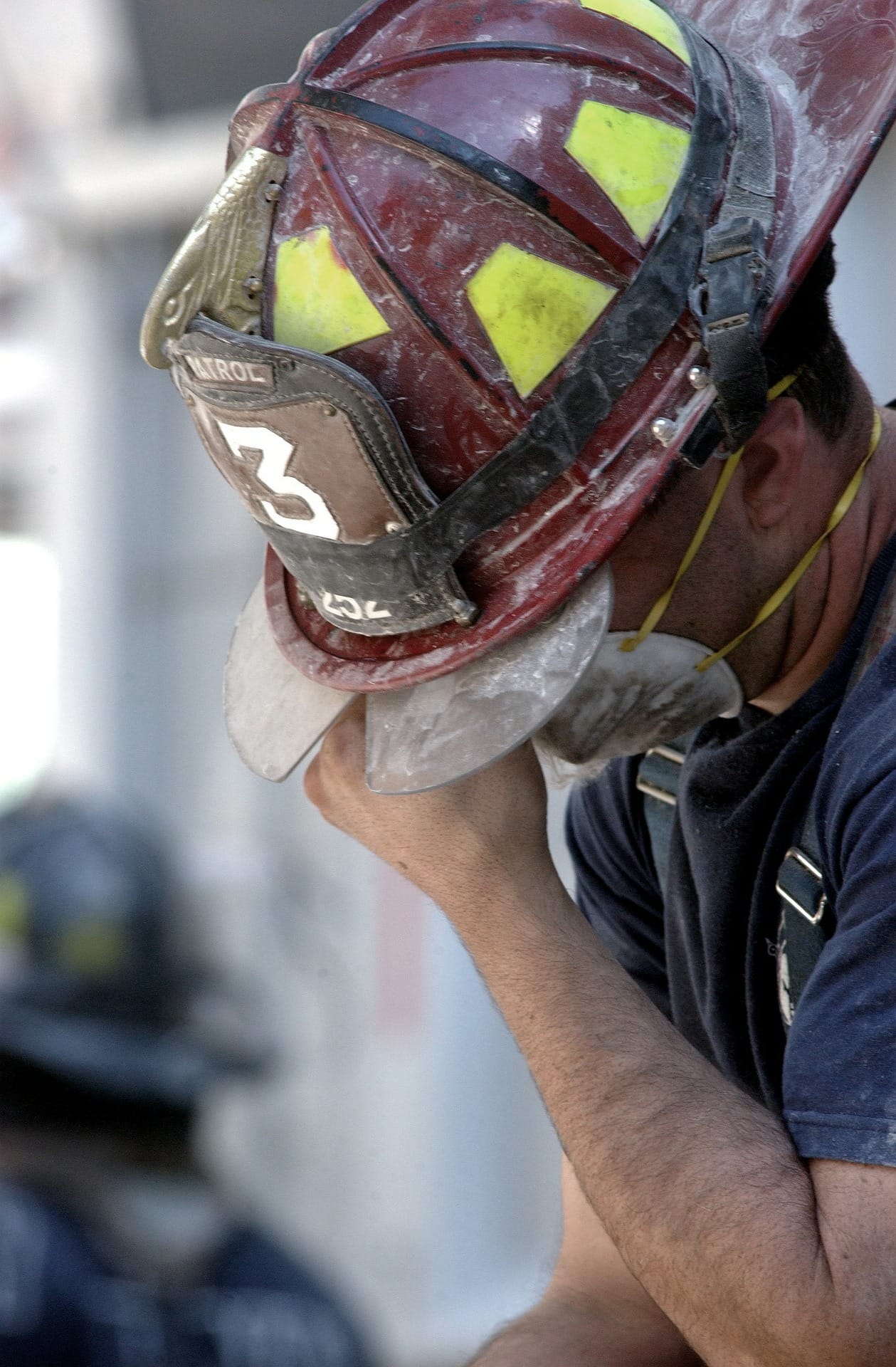
Rescuers in critical need:
the hazardous stigma of mental problems
Second-year Psychology students participating in the University Honours College follow a mini-course on Blogging Science (within the Thematic Meetings course), in which they learn to communicate science to the general public, by means of informing, giving an opinion, and relating issues in science to issues in society. This year a selection of these written blog posts is published on Mindwise. Today’s post is by Sannah de Jon.
On January 22nd 2014, 49-year-old Michael Mauser hanged himself in Clarksville, Tennessee. He had been a firefighter for more than 30 years. ‘I think that there was an element of PTSD for him, because he would wake up about every four hours at night and pace the house and check on everything, and then go back to bed.’, said his daughter, Lauren Ferguson (Bah, 2016). He had seen tragic things during fires such as entire families being burned up, and been completely obsessed with the thought that it might happen to his own family. He had concealed a lot of emotions, so no one had seen his suicide coming. Unfortunately, this suicide isn’t just an exception. Michael Mauser was one of many firefighters who killed themselves that year. First responders – firefighters, paramedics, police officers and others saving lives in case of emergency – experience tragedy and danger on a regular basis. Over time, cumulative exposure to work-related traumatic events often leads to stress-related mental disorders in first responders (Geronazzo-Alman et al., 2017).
113 firefighters and paramedics took their own lives in 2015. Moreover, according to the National Fallen Firefighters Foundation (NFFF), it is three times more likely for a firefighter to kill himself than to die in line of duty
We cannot downplay the seriousness of the growing number of first responders taking their own lives. Moving beyond this individual case, one estimate of the Firefighter Behavioral Health Alliance (FBHA) states that a record 113 firefighters and paramedics took their own lives in 2015. Moreover, according to the National Fallen Firefighters Foundation (NFFF), it is three times more likely for a firefighter to kill himself than to die in line of duty (Bah, 2016). Let’s clarify the stated phenomenon somewhat. In the case of Michael Mauser, the stress he encountered due to the horrifying events he witnessed could have led him to focus more on his emotions as a way of coping with the events. However, the resulting frustrations and intrusions might have caused symptoms of post-traumatic stress disorder which has even resulted in depression and ended in the suicide (Stanley, Hom, & Joiner, 2016). In the broader context, suicide risk is indirectly affected by PTSD symptoms by increasing the severity of cognitive-emotional factors, not just for fire fighters or veterans facing similar problems (McKinney, Hirsch, & Britton, 2017).
A central concern is that very few first responders ask for help. Fires, mass shootings, child abuse, earthquakes… the events that first responders experience often lead them to be seen as heroes rather than victims. ‘He was a giant, people around here call him a legend’, claimed Lauren of her father Michael. In the context of this (deserved) positive image, it can be difficult to admit mental problems. Indeed mental healthcare is alarmingly stigmatized among first responders. Is this stigmatisation evidence that first responders disapprove any type of weakness, whether physical or mental? As paradoxically as it sounds, the admiration our society often shows to first responders could cause them to feel they are not living up the ideal of being brave and courageous. This can make the step to seeking mental healthcare a difficult one to take, and highlights two issues that badly need our attention.
Responders may fear that admitting that they are not doing well mentally will be seen as them not being suitable for the job. As people may consider their job a part of their identity, this could be a terrifying thought.
First, how do we make sure that first responders receive the right help at the right time? Responders may fear that admitting that they are not doing well mentally will be seen as them not being suitable for the job. As people may consider their job a part of their identity, this could be a terrifying thought. Stigma can occur when status loss co-occurs, as is the case in the eyes of some first responders, and so affects those with mental health problems (Royle, Keenan, & Farrell, 2009). This might prevent many first responders from seeking care.
Second, how can we reduce the burdensome stigma attached to first responders having mental health problems? First responders seem to be extremely sensitive to this and it may keep them from getting help. Health problems are as common as leaves on trees, but particularly when they are mental rather than physical in nature, people start discriminating and getting embarrassed. How come?
Simple as it sounds, mental health problems need to be accepted as normal. Only that way may they be treated like a sprained ankle is being treated. People need to be educated on mental problems and their corresponding attitude needs to be changed.
Our current attitude is crying out to be revised. We humans still struggle to recognize mental health problems as a sign of being human. Simple as it sounds, mental health problems need to be accepted as normal. Only that way may they be treated like a sprained ankle is being treated. People need to be educated on mental problems and their corresponding attitude needs to be changed. Fortunately, a growing number of clinical researchers is working to reduce the stigma and discrimination associated with mental illness. This has yielded promising theoretical and practical considerations of how to implement anti-stigma interventions in healthcare (Ungar, Knaak, & Szeto, 2016). As stigmatizing processes can affect multiple domains of our lives and given that there are many stigmatized circumstances, the current line of thinking is that multi-dimensional approaches need to address stigma holistically.
Michael Mauser is not the only fire fighter to commit suicide, nor will he be the last one. Combating stigma in mental healthcare is no easy task. There is still a long way to go before we have abolished it. Treating mental illnesses requires that both individuals who are suffering and the society they live in acknowledge the problem. This will be the first and most important step towards rescuing our first responders.
Note: Image by tpsdave, licensed by CC0
References
Bah, A. (2016, February 20). Amid culture of silence, more firefighters die of suicide than on the job. Aljazeera America. Retrieved from http://america.aljazeera.com/watch/shows/fault-lines/articles/2016/2/20/amid-culture-of-silence-more-firefighters-die-of-suicide-than-on-the-job.html
Geronazzo-Alman, L., Eisenberg, R., Shen, S., Duarte, C., Musa, G., Wicks, J., Fan, B., Doan, T., Guffanti, G. (2017). Cumulative exposure to work-related traumatic events and current post-traumatic stress disorder in New York City’s first responders. Comprehensive Psychiatry, 74, 134-143.
McKinney, J. M., Hirsch, J. K., & Britton, P. C. (2017). PTSD symptoms and suicide risk in veterans: Serial indirect effects via depression and anger. Journal Of Affective Disorders, 214100-107. doi:10.1016/j.jad.2017.03.008
Royle, L., Keenan, P., & Farrell, D. (2009). Issues of stigma for first responders accessing support for post-traumatic stress. International Journal Of Emergency Mental Health, 11(2), 79-86.
Stanley, I. H., Hom, M. A., & Joiner, T. E. (2016). A systematic review of suicidal thoughts and behaviors among police officers, firefighters, EMTs, and paramedics. Clinical Psychology Review, 4425-44. doi:10.1016/j.cpr.2015.12.002
Ungar, T., Knaak, S., & Szeto, A. C. (2016). Theoretical and practical considerations for combating mental illness stigma in health care. Community Mental Health Journal, 52(3), 262-271. doi:10.1007/s10597- 015-9910-4



